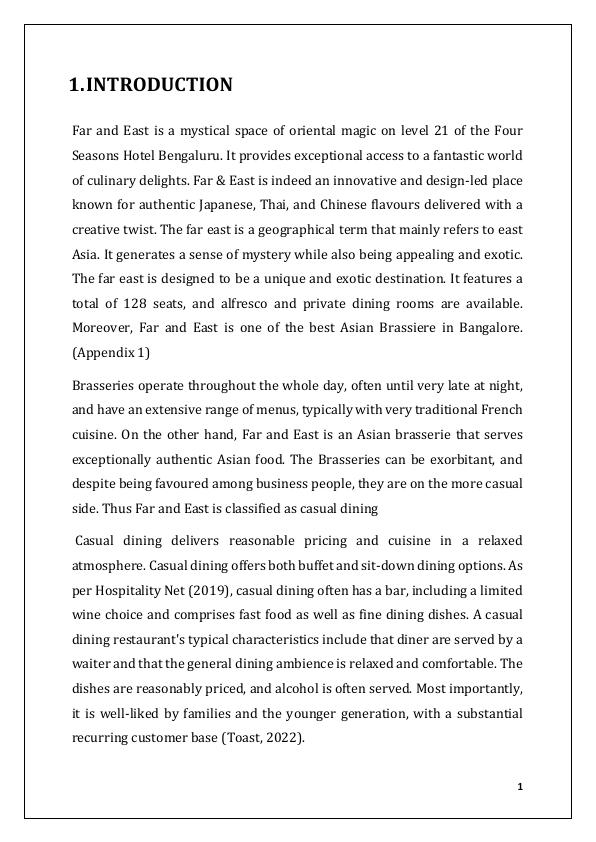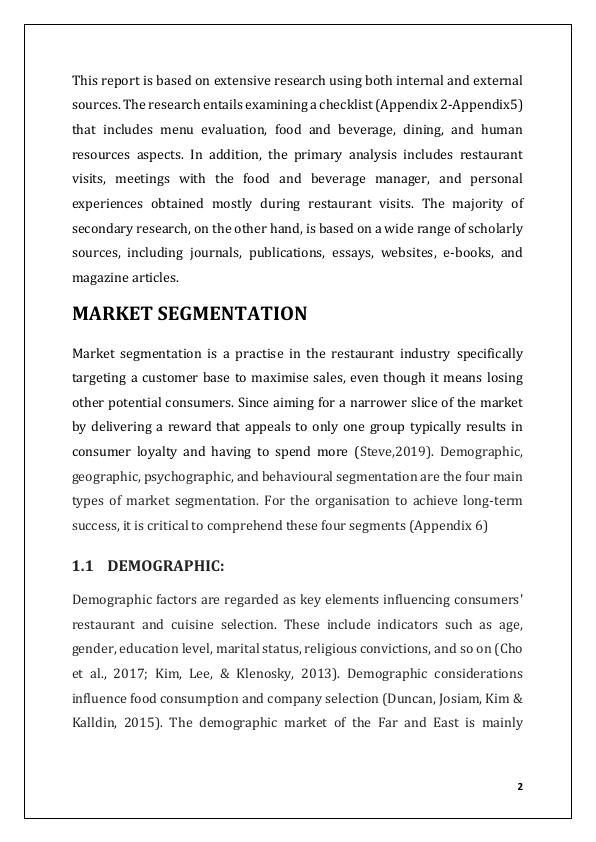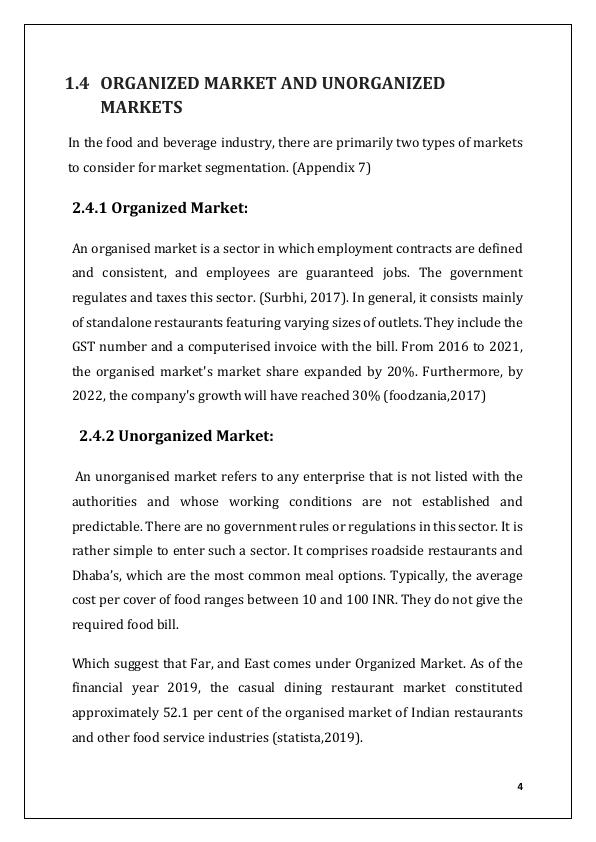Report on Strategic Management of Far and East, Four Seasons
14 Pages2912 Words44 Views
Added on 2022-05-02
About This Document
The report below discusses the strategic management of Far and East, Four Seasons, a restaurant that offers casual dining. This research examined casual dining restaurants as well as the operation's customer categories and target audience. Far and East's customers are Millenials, Generation X, Generation Y, and Generation Z. The challenges of the Far and East are unorganized market competitors offering nearly identical menus and cuisine at lower prices, as well as competitors' greater media advertising.
Report on Strategic Management of Far and East, Four Seasons
Added on 2022-05-02
ShareRelated Documents
1
1.INTRODUCTION
Far and East is a mystical space of oriental magic on level 21 of the Four
Seasons Hotel Bengaluru. It provides exceptional access to a fantastic world
of culinary delights. Far & East is indeed an innovative and design-led place
known for authentic Japanese, Thai, and Chinese flavours delivered with a
creative twist. The far east is a geographical term that mainly refers to east
Asia. It generates a sense of mystery while also being appealing and exotic.
The far east is designed to be a unique and exotic destination. It features a
total of 128 seats, and alfresco and private dining rooms are available.
Moreover, Far and East is one of the best Asian Brassiere in Bangalore.
(Appendix 1)
Brasseries operate throughout the whole day, often until very late at night,
and have an extensive range of menus, typically with very traditional French
cuisine. On the other hand, Far and East is an Asian brasserie that serves
exceptionally authentic Asian food. The Brasseries can be exorbitant, and
despite being favoured among business people, they are on the more casual
side. Thus Far and East is classified as casual dining
Casual dining delivers reasonable pricing and cuisine in a relaxed
atmosphere. Casual dining offers both buffet and sit-down dining options. As
per Hospitality Net (2019), casual dining often has a bar, including a limited
wine choice and comprises fast food as well as fine dining dishes. A casual
dining restaurant's typical characteristics include that diner are served by a
waiter and that the general dining ambience is relaxed and comfortable. The
dishes are reasonably priced, and alcohol is often served. Most importantly,
it is well-liked by families and the younger generation, with a substantial
recurring customer base (Toast, 2022).
1.INTRODUCTION
Far and East is a mystical space of oriental magic on level 21 of the Four
Seasons Hotel Bengaluru. It provides exceptional access to a fantastic world
of culinary delights. Far & East is indeed an innovative and design-led place
known for authentic Japanese, Thai, and Chinese flavours delivered with a
creative twist. The far east is a geographical term that mainly refers to east
Asia. It generates a sense of mystery while also being appealing and exotic.
The far east is designed to be a unique and exotic destination. It features a
total of 128 seats, and alfresco and private dining rooms are available.
Moreover, Far and East is one of the best Asian Brassiere in Bangalore.
(Appendix 1)
Brasseries operate throughout the whole day, often until very late at night,
and have an extensive range of menus, typically with very traditional French
cuisine. On the other hand, Far and East is an Asian brasserie that serves
exceptionally authentic Asian food. The Brasseries can be exorbitant, and
despite being favoured among business people, they are on the more casual
side. Thus Far and East is classified as casual dining
Casual dining delivers reasonable pricing and cuisine in a relaxed
atmosphere. Casual dining offers both buffet and sit-down dining options. As
per Hospitality Net (2019), casual dining often has a bar, including a limited
wine choice and comprises fast food as well as fine dining dishes. A casual
dining restaurant's typical characteristics include that diner are served by a
waiter and that the general dining ambience is relaxed and comfortable. The
dishes are reasonably priced, and alcohol is often served. Most importantly,
it is well-liked by families and the younger generation, with a substantial
recurring customer base (Toast, 2022).

2
This report is based on extensive research using both internal and external
sources. The research entails examining a checklist (Appendix 2-Appendix5)
that includes menu evaluation, food and beverage, dining, and human
resources aspects. In addition, the primary analysis includes restaurant
visits, meetings with the food and beverage manager, and personal
experiences obtained mostly during restaurant visits. The majority of
secondary research, on the other hand, is based on a wide range of scholarly
sources, including journals, publications, essays, websites, e-books, and
magazine articles.
MARKET SEGMENTATION
Market segmentation is a practise in the restaurant industry specifically
targeting a customer base to maximise sales, even though it means losing
other potential consumers. Since aiming for a narrower slice of the market
by delivering a reward that appeals to only one group typically results in
consumer loyalty and having to spend more (Steve,2019). Demographic,
geographic, psychographic, and behavioural segmentation are the four main
types of market segmentation. For the organisation to achieve long-term
success, it is critical to comprehend these four segments (Appendix 6)
1.1 DEMOGRAPHIC:
Demographic factors are regarded as key elements influencing consumers'
restaurant and cuisine selection. These include indicators such as age,
gender, education level, marital status, religious convictions, and so on (Cho
et al., 2017; Kim, Lee, & Klenosky, 2013). Demographic considerations
influence food consumption and company selection (Duncan, Josiam, Kim &
Kalldin, 2015). The demographic market of the Far and East is mainly
This report is based on extensive research using both internal and external
sources. The research entails examining a checklist (Appendix 2-Appendix5)
that includes menu evaluation, food and beverage, dining, and human
resources aspects. In addition, the primary analysis includes restaurant
visits, meetings with the food and beverage manager, and personal
experiences obtained mostly during restaurant visits. The majority of
secondary research, on the other hand, is based on a wide range of scholarly
sources, including journals, publications, essays, websites, e-books, and
magazine articles.
MARKET SEGMENTATION
Market segmentation is a practise in the restaurant industry specifically
targeting a customer base to maximise sales, even though it means losing
other potential consumers. Since aiming for a narrower slice of the market
by delivering a reward that appeals to only one group typically results in
consumer loyalty and having to spend more (Steve,2019). Demographic,
geographic, psychographic, and behavioural segmentation are the four main
types of market segmentation. For the organisation to achieve long-term
success, it is critical to comprehend these four segments (Appendix 6)
1.1 DEMOGRAPHIC:
Demographic factors are regarded as key elements influencing consumers'
restaurant and cuisine selection. These include indicators such as age,
gender, education level, marital status, religious convictions, and so on (Cho
et al., 2017; Kim, Lee, & Klenosky, 2013). Demographic considerations
influence food consumption and company selection (Duncan, Josiam, Kim &
Kalldin, 2015). The demographic market of the Far and East is mainly

3
composed of Millenials, and Gen Xers aged 20 to 50. The sector is segmented
by wealth and targets the middle and upper classes.
1.2 GEOGRAPHIC:
Geographic segmentation divides customers into several target consumer
groups based on their location. Since potential customers' demands,
preferences, and interests fluctuate based on their geography. Choosing a
densely urbanised location like Bangalore to launch an Asian brassiere was
among the four seasons' best investments. Bangalore has a population of over
9.5 million people. 70% of them are under the age of 55 and have an average
age of 24. (Gottschling, M., 2016). An Asian Brassiere in Bangalore was the
Ideal potential market. Furthermore, a transient market such as Bangalore
has always preferred unique as well as Asian cuisine.
1.3 PSYCHOLOGICAL AND BEHAVIOURAL
Psychographic segmentation evaluates the psychological components of
customer behaviour by categorising markets based on customers' lifestyles,
personal characteristics, beliefs, opinions, and interests. Behavioural
segmentation, on the other hand, divides markets based on behaviours and
judgement patterns such as purchasing, consumption, and usage. Far and
East's behavioural and psychological segmentation is centred on consumers
seeking a one-of-a-kind experience and millennials who perceive and
comprehend art. Far and East attempts to appeal to consumers who are not
excessively concerned about price.
composed of Millenials, and Gen Xers aged 20 to 50. The sector is segmented
by wealth and targets the middle and upper classes.
1.2 GEOGRAPHIC:
Geographic segmentation divides customers into several target consumer
groups based on their location. Since potential customers' demands,
preferences, and interests fluctuate based on their geography. Choosing a
densely urbanised location like Bangalore to launch an Asian brassiere was
among the four seasons' best investments. Bangalore has a population of over
9.5 million people. 70% of them are under the age of 55 and have an average
age of 24. (Gottschling, M., 2016). An Asian Brassiere in Bangalore was the
Ideal potential market. Furthermore, a transient market such as Bangalore
has always preferred unique as well as Asian cuisine.
1.3 PSYCHOLOGICAL AND BEHAVIOURAL
Psychographic segmentation evaluates the psychological components of
customer behaviour by categorising markets based on customers' lifestyles,
personal characteristics, beliefs, opinions, and interests. Behavioural
segmentation, on the other hand, divides markets based on behaviours and
judgement patterns such as purchasing, consumption, and usage. Far and
East's behavioural and psychological segmentation is centred on consumers
seeking a one-of-a-kind experience and millennials who perceive and
comprehend art. Far and East attempts to appeal to consumers who are not
excessively concerned about price.

4
1.4 ORGANIZED MARKET AND UNORGANIZED
MARKETS
In the food and beverage industry, there are primarily two types of markets
to consider for market segmentation. (Appendix 7)
2.4.1 Organized Market:
An organised market is a sector in which employment contracts are defined
and consistent, and employees are guaranteed jobs. The government
regulates and taxes this sector. (Surbhi, 2017). In general, it consists mainly
of standalone restaurants featuring varying sizes of outlets. They include the
GST number and a computerised invoice with the bill. From 2016 to 2021,
the organised market's market share expanded by 20%. Furthermore, by
2022, the company's growth will have reached 30% (foodzania,2017)
2.4.2 Unorganized Market:
An unorganised market refers to any enterprise that is not listed with the
authorities and whose working conditions are not established and
predictable. There are no government rules or regulations in this sector. It is
rather simple to enter such a sector. It comprises roadside restaurants and
Dhaba’s, which are the most common meal options. Typically, the average
cost per cover of food ranges between 10 and 100 INR. They do not give the
required food bill.
Which suggest that Far, and East comes under Organized Market. As of the
financial year 2019, the casual dining restaurant market constituted
approximately 52.1 per cent of the organised market of Indian restaurants
and other food service industries (statista,2019).
1.4 ORGANIZED MARKET AND UNORGANIZED
MARKETS
In the food and beverage industry, there are primarily two types of markets
to consider for market segmentation. (Appendix 7)
2.4.1 Organized Market:
An organised market is a sector in which employment contracts are defined
and consistent, and employees are guaranteed jobs. The government
regulates and taxes this sector. (Surbhi, 2017). In general, it consists mainly
of standalone restaurants featuring varying sizes of outlets. They include the
GST number and a computerised invoice with the bill. From 2016 to 2021,
the organised market's market share expanded by 20%. Furthermore, by
2022, the company's growth will have reached 30% (foodzania,2017)
2.4.2 Unorganized Market:
An unorganised market refers to any enterprise that is not listed with the
authorities and whose working conditions are not established and
predictable. There are no government rules or regulations in this sector. It is
rather simple to enter such a sector. It comprises roadside restaurants and
Dhaba’s, which are the most common meal options. Typically, the average
cost per cover of food ranges between 10 and 100 INR. They do not give the
required food bill.
Which suggest that Far, and East comes under Organized Market. As of the
financial year 2019, the casual dining restaurant market constituted
approximately 52.1 per cent of the organised market of Indian restaurants
and other food service industries (statista,2019).

End of preview
Want to access all the pages? Upload your documents or become a member.
Related Documents
Food and Beverage Management Assignment 2022lg...
|11
|1537
|19
